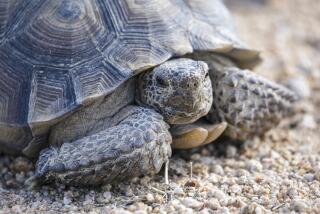Scientists fear for the world’s most endangered sea turtle as the Park Service cuts back
- Share via
WASHINGTON — Every summer, thousands of people travel to Padre Island National Seashore at dawn to cheer on sea turtle hatchlings as they are released into the surf.
It’s a huge tourist attraction for this national park on the Texas coast and a conservation success story — the result of a decades-long effort to save the most endangered sea turtle from extinction.
But after more than 40 years of supporting and celebrating the program, National Park Service officials appear to have soured on paying for it.
In a recent report, agency officials proposed sweeping changes to the park’s conservation efforts that scientists said would make it significantly more difficult, if not impossible, to establish a thriving population of Kemp’s ridley sea turtles on the island.
The report suggested that saving sea turtles was taking up too much of the park’s budget and came at the expense of other priorities, like habitat restoration and trash cleanup. It called for decreasing the number of beach patrols to find turtle nests, limiting biologists’ research to the park’s boundaries, and moving away from the practice of gathering and incubating turtle eggs in order to protect them from predators, rising tides and visitors driving on the beach.
The park’s enormously popular hatchling releases are “discretionary,” the report said, and “should be reduced” to save money.
“I’m really shocked,” said Christopher Marshall, director of the Gulf Center for Sea Turtle Research at Texas A&M University at Galveston. If the agency’s recommendations are put in place,”there’ll be less scientific study and there’ll be less known about sea turtles in general,” he said. “I do think the gains we have achieved in the last decade will be undermined.”
Lawyers with the nonprofit group Public Employees for Environmental Responsibility filed a legal complaint on Wednesday with the National Park Service on behalf of one of the park’s employees, Donna Shaver, chief of the Sea Turtle Science and Recovery Program. They called for the report to be rescinded, arguing that accepting its recommendations would violate the Endangered Species Act.
Pacific PEER Director Jeff Ruch said that since the report’s publication in June, Padre Island National Seashore Supt. Eric Brunnemann had ordered the program’s budget slashed by 30%. Two federal grants totaling $300,000 for research on threatened green sea turtles have already been canceled, he said. In the agency’s report, officials recommended that park staff focus almost entirely on Kemp ridleys, ending their collection and care for green and loggerhead sea turtle eggs.
A park spokesman declined a request to interview Shaver.
In a statement sent after this story was published online, Brunnemann said: “The National Park Service’s only plan forward is to strengthen the program, which is built by the support of our employees and volunteers.”
In 1978, when the Kemp’s ridley nesting program at Padre Island began, the species was in such peril that biologists began sending them to zoos and aquariums, convinced the turtles were on the brink of extinction. Though the turtles mainly nested in Mexico, they had been so heavily poached that scientists decided to create a second colony in the United States to improve the species’ odds of surviving natural disasters and human interference.
Throughout the ‘80s, scientists worked to persuade turtles to think of Padre Island as their new home. They transported thousands of eggs from nests in Mexico to the narrow barrier island, releasing hatchlings into the Gulf of Mexico and crossing their fingers that the turtles might come back again.
The entire experiment rested on the then-controversial idea that female sea turtles would return to the beach where they were born to spawn. In 1996, the first ones did.
The Kemp’s ridley is still critically endangered, but its numbers have been growing, peaking in 2017 when beach patrollers found 353 nests in Texas.
And with that growth came national attention. The National Park Service increased the turtle conservation program’s funding in the mid-2000s, and Shaver won millions of dollars in grant funding to support her work. Earlier this year, she was named a finalist for the Samuel J. Heyman Service to America Medals, better known as the “Sammies” or the “Oscars of Government Service,” one of the highest honors for a federal public servant.
When the agency issued its report in June, sea turtle scientists in Texas said they were stunned by its calls for budget cuts and restrictions on research.
“It’s definitely a money-grab, in my opinion,” said Jeff George, the executive director of Sea Turtle Inc, a privately run rescue center on South Padre Island. George, who was interviewed by the report’s authors, said they had dismissed the Kemp ridley’s numbers in Texas as only a tiny fraction of the species’ overall population and downplayed the significance of the park’s conservation efforts.
“They don’t understand the realities of Texas and just how vast and remote it is. They don’t know how tenuous things were in Mexico last year and can be from year to year,” he said. “All they see is a lot of money spent for 1% of the population.”
Some scientists were especially critical of the report’s recommendation that turtle eggs be increasingly left in their nests or placed in protective corrals, rather than excavated and brought to an incubation room.
Kemp’s ridley nests are easily invaded by hungry coyotes and fire ants or destroyed by tides that can extend up to the dunes. If beach patrollers don’t collect the eggs soon after they’re deposited in a nest, they’re often too late.
Texas law also poses a unique challenge. Beaches are classified as public roadways and year-round beach driving is allowed at Padre Island.
Yet to agency officials, the program’s conservation practices seem excessive. “Whether this level of intensive wildlife management is still necessary is a legitimate scientific question now that Kemp’s numbers have increased from the low identified in the 1970s that prompted intervention,” the report said.
Marshall and other scientists insist it is. While the species’ numbers have increased, many biologists consider the Padre Island nesting site a work in progress that’s far from established.
“Because these turtles are so critically endangered, every egg matters,” Marshall said. “Why would you take the risk of losing half your nests on the upper Texas coast? Maintaining the alternate colony is very important. It doesn’t matter what the percentage is — this is our insurance policy.”
More to Read
Get the L.A. Times Politics newsletter
Deeply reported insights into legislation, politics and policy from Sacramento, Washington and beyond. In your inbox twice per week.
You may occasionally receive promotional content from the Los Angeles Times.











